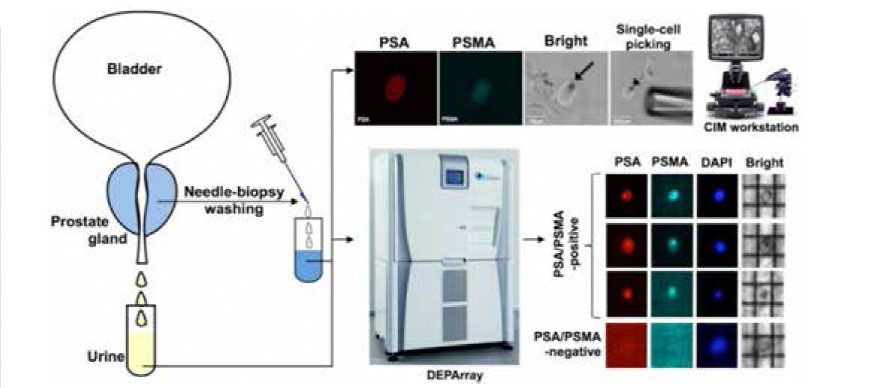The Era of Interrogating Single Cells in Cancer Biopsy Is Now
Even in seemingly uniform cell populations within subcompartments, cell-cell heterogeneity is becoming more evident, far beyond what was previously expected.
Nameer B. Kirma, PhD
Cancer Therapy & Research Center
The University of Texas Health Science Center at San Antonio
Chun-Liang Chen, PhD
Cancer Therapy & Research Center
The University of Texas Health Science Center at San Antonio
Tim H.-M. Huang, PhD
Cancer Therapy & Research Center
The University of Texas Health Science Center at San Antonio
Moving through a crowd of people, if one pays attention to individuals, it’s easy to discern different characteristics that make each person unique. Likewise, scientists have long conceptualized variations in cells comprising the different tissue compartments in the human body. Yet, even in seemingly uniform cell populations within subcompartments, cell-cell heterogeneity is becoming more evident, far beyond what was previously expected.
We can attribute this new awareness to the advent of innovative technologies that enable us to maneuver and manipulate single cells in fine-tuned microfluidic channels and to increasingly sensitive methods that probe metabolites, macromolecules, and cellular nano-physical structures. At present, researchers from both academic and corporate organizations are aggressively pursuing to optimize and develop more sensitive methods. Indeed, the era of noninvasive single cell biopsy is at hand!
Why does paying attention to single cells matter? Classically, biological research has focused on the analysis of pooled cells, from the thousands to the millions. Paradoxically, these conventional assays requiring the use of pooled cells suffer from limits of detection, and as a result, important alterations in a subset of effector cells within a cell population are overlooked, their relevance diluted in a sea of averages.
Normally, the alterations in cell physiology and molecular parameters (eg, cell biophysical features and gene expression profiles) are important in maintaining homeostasis and biological processes, such as development. But the aberrant changes that occur in a small population of cells or even in a single initiating cell can be pivotal for the development and progression of diseases, such as cancer and the acquisition of resistance to therapy.
Figure 1.
Figure 1. Single-cell isolation and characterization using CIM and DEPArray systems, respectively. Individual PSA/PSMA-positiveprostate epithelial cells have been isolated from urine or needle biopsy washes for downstream analysis using BioMark or AFM.The same approaches will be used to isolate epithelial cancer cells and the associated stromal fibroblasts from endocervicalbrushes and to isolate circulating rare cells from blood samples of cancer patients.

Single-cell isolation and characterization using CIM and DEPArray systems, respectively. Individual PSA/PSMA-positive prostate epithelial cells have been isolated from urine or needle biopsy washes for downstream analysis using BioMark or AFM. The same approaches will be used to isolate epithelial cancer cells and the associated stromal fibroblasts from endocervical brushes and to isolate circulating rare cells from blood samples of cancer patients.
Here at The University of Texas Health Science Center at San Antonio, we have developed the Single-Cell Biopsy and Characterization Core (SBCC), which recently received prestigious funding from the Cancer Prevention and Research Institute of Texas (CPRIT).
The SBCC will implement and develop a single cell manipulation and analysis pipeline to provide: 1) clinical sample processing for single-cell isolation and banking; 2) high-throughput single-cell analysis platforms; and 3) data integration by single-cell specialized bioinformatics.
Furthermore, we have developed and are continuously optimizing new methods to isolate single cells from limited clinical materials, including: 1) exfoliated cancer cells from urine, as well as endocervical and oral brushes; 2) circulating rare cells in blood (eg, singular circulating tumor cells [CTCs], clustered CTCs, circulating macrophages, and circulating adipose stromal cells); and 3) epithelial cancer cells and stromal fibroblasts from needle biopsy washes.
A major advantage for single-cell biopsy is that small amounts of clinical materials are used in cancer detection without interference with standard pathology diagnostics. Furthermore, the development of noninvasive methodologies, such as liquid biopsies, will allow us to actively monitor disease development or progression in high-risk patient populations. Intratumor heterogeneity can also be interrogated by single-cell analysis. Hidden within the milieu of clonal tumor cells, sometimes stroma, and inflammatory cells, there might lie a population of tumor initiating cells with distinct physical characteristics and molecular expression profiles. These cells could emerge as recurrent tumors after the elimination of the clonal tumor cell population by first-line therapeutic intervention of the primary tumor. Characterizing this phantom menace by single-cell analysis can lead to stratification of patients at risk of recurrence or developing drug resistance.
Figure 2.
(A), BioMark/microfluidic chip system forsingle-cell expression analysis of candidate genes andmicrofluidic chip. (B) Expression heat map and representativeamplification curves and melting point peaks from asingle-cell PCR assay. Single-cell protein detection can besimilarly analyzed using the proximity ligation assay.

(A), BioMark/microfluidic chip system for single-cell expression analysis of candidate genes and microfluidic chip.
(B) Expression heat map and representative amplification curves and melting point peaks from a single-cell PCR assay. Single-cell protein detection can be similarly analyzed using the proximity ligation assay.
With a view to developing and enhancing our single-cell analysis pipeline and serving the research community, we have acquired manual immunofluorescence- micromanipulator workstations and a DEPArray unit (Silicone Biosystems, Inc), which uses dielectrophoresis to separate single cells or subpopulation of cells in suspension within a microelectronic array (Figure 1). As presented in Figure 2, the Biomark HD MX/HX system (Fluidigm, Inc) is used to determine single-cell expression of gene panels in a 48 x 48 microfluidic chip format, which can assay the expression of 48 genes in 48 single cells on one chip (4 nanoliter per reaction; total, 2304 reactions). A 96 x 96 loading platform is also available. The Catalyst Atomic Force Microscope unit (Bruker, Inc) has the capacity to collect quantitative nanophysical/mechanical data (eg, cell adhesiveness and elasticity), along with tapping, force, and contact modes of single cells. With the help of this state-of-the-art facility, the interphase between clinical sampling and single-cell analysis is currently within our grasp.
The development of such noninvasive tools requiring minimal clinical samples will help us to examine heterogeneity within tumors, which can be a determinant of cancer growth, metastatic spread, and drug response. Detecting and characterizing populations of culprit cells will greatly enhance our capabilities to actively monitor cancer progression, predict clinical outcome, and design personalized therapy.




